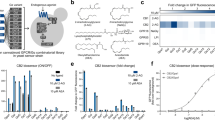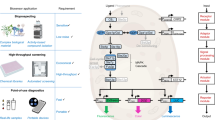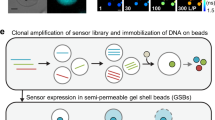Abstract
We report a step-by-step protocol describing how to develop and use a yeast-based bioassay for androgen-like compounds. Saccharomyces cerevisiae cells are genetically engineered to express the human androgen receptor (hAR) and the bioluminescent (BL) reporter gene luciferase (from Photinus pyralis) under the control of the androgen response element (ARE). In the presence of androgens, activated hAR binds to the ARE sequences and activates luciferase expression. After addition of D-luciferin, luciferase activity measurements can be performed, and the BL signal is proportional to the androgenic activity of the sample. Cytotoxic effects of the sample are monitored by the use of a control yeast strain that allows BL signal correction according to cell viability. After overnight culture of the recombinant strain, the assay can be accomplished in a 96-well microplate format in 1 working day with a detection limit of 0.05 nM for testosterone and intra- and interassay variability of 14% and 23%, respectively.
This is a preview of subscription content, access via your institution
Access options
Subscribe to this journal
Receive 12 print issues and online access
$259.00 per year
only $21.58 per issue
Buy this article
- Purchase on Springer Link
- Instant access to full article PDF
Prices may be subject to local taxes which are calculated during checkout




Similar content being viewed by others
References
Singh, S.M., Gauthier, S. & Labrie, F. Androgen receptor antagonists (antiandrogens): structure–activity relationships. Curr. Med. Chem. 7, 211–247 (2000).
Verrijdt, G., Haelens, A. & Claessens, F. Selective DNA recognition by the androgen receptor as a mechanism for hormone-specific regulation of gene expression. Mol. Genet. Metab. 78, 175–185 (2003).
Xu, L.C. et al. Evaluation of androgen receptor transcriptional activities of some pesticides in vitro . Toxicology 243, 59–65 (2008).
Henley, D.V. & Korach, K.S. Endocrine-disrupting chemicals use distinct mechanisms of action to modulate endocrine system function. Endocrinology 147, 25–32 (2006).
Kortenkamp, A. Ten years of mixing cocktails: a review of combination effects of endocrine-disrupting chemicals. Environ. Health Perspect. 115, 98–105 (2007).
Orlando, E.F. & Guillette, L.J. Jr. Sexual dimorphic responses in wildlife exposed to endocrine disrupting chemicals. Environ. Res. 104, 163–173 (2007).
Wolff, M.S. et al. Environmental exposures and puberty in inner-city girls. Environ. Res. 107, 393–400 (2008).
Den Hond, E. & Schoeters, G. Endocrine disrupters and human puberty. Int. J. Androl. 29, 264–271 (2006).
Schoeters, G., Den Hond, E., Dhooge, W., van Larebeke, N. & Leijs, M. Endocrine disruptors and abnormalities of pubertal development. Basic Clin. Pharmacol. Toxicol. 102, 168–175 (2008).
Stuart, J.D. Determination of endocrine disrupting chemicals found in environmental samples by gas chromatography/mass spectrometry. Adv. Chromatogr. 45, 245–273 (2007).
Ikonomou, M.G., Cai, S.S., Fernandez, M.P., Blair, J.D. & Fischer, M. Ultra-trace analysis of multiple endocrine-disrupting chemicals in municipal and bleached kraft mill effluents using gas chromatography-high-resolution mass spectrometry. Environ. Toxicol. Chem. 27, 243–251 (2008).
Yu, Z., Peldszus, S. & Huck, P.M. Optimizing gas chromatographic-mass spectrometric analysis of selected pharmaceuticals and endocrine-disrupting substances in water using factorial experimental design. J. Chromatogr. A. 1148, 65–77 (2007).
Roda, A. et al. Analytical approach for monitoring endocrine-disrupting compounds in urban waste water treatment plants. Anal. Bioanal. Chem. 385, 742–752 (2006).
Nelson, J., Bishay, F., van Roodselaar, A., Ikonomou, M. & Law, F.C. The use of in vitro bioassays to quantify endocrine disrupting chemicals in municipal wastewater treatment plant effluents. Sci. Total Environ. 374, 80–90 (2007).
Bovee, T.F., Lommerse, J.P., Peijnenburg, A.A., Fernandes, E.A. & Nielen, M.W. A new highly androgen specific yeast biosensor, enabling optimisation of (Q)SAR model approaches. J. Steroid Biochem. Mol. Biol. 108, 121–131 (2008).
Sonneveld, E., Jansen, H.J., Riteco, J.A., Brouwer, A. & van der Burg, B. Development of androgen- and estrogen-responsive bioassays, members of a panel of human cell line-based highly selective steroid-responsive bioassays. Toxicol. Sci. 83, 136–148 (2005).
Simon, S. & Mueller, S.O. Human reporter gene assays: transcriptional activity of the androgen receptor is modulated by the cellular environment and promoter context. Toxicology 220, 90–103 (2006).
Chen, J. et al. Circulating bioactive androgens in midlife women. J. Clin. Endocrinol. Metab. 91, 4387–4394 (2006).
Raivio, T., Palvimo, J.J., Dunkel, L., Wickman, S. & Jänne, O.A. Novel assay for determination of androgen bioactivity in human serum. J. Clin. Endocrinol. Metab. 86, 1539–1544 (2001).
Roy, P. et al. Screening of some anti-androgenic endocrine disruptors using a recombinant cell-based in vitro bioassay. J. Steroid Biochem. Mol. Biol. 88, 157–166 (2004).
Eldridge, M.L. et al. Saccharomyces cerevisiae BLYAS, a new bioluminescent bioreporter for detection of androgenic compounds. Appl. Environ. Microbiol. 73, 6012–6018 (2007).
Beck, V., Reiter, E. & Jungbauer, A. Androgen receptor transactivation assay using green fluorescent protein as a reporter. Anal. Biochem. 373, 263–271 (2008).
Bovee, T.F. et al. A new highly specific and robust yeast androgen bioassay for the detection of agonists and antagonists. Anal. Bioanal. Chem. 389, 1549–1558 (2007).
Roda, A., Pasini, P., Mirasoli, M., Michelini, E. & Guardigli, M. Biotechnological applications of bioluminescence and chemiluminescence. Trends Biotechnol. 22, 295–303 (2004).
Lundin, A. Optimised assay of firefly luciferase with stable light emission. In Bioluminescence and Chemiluminescence: Status Report (eds. Szalay, A., Kricka, L.J., Stanley, P.E.) 291–295 (John Wiley, Chichester, UK, 1993).
Chatterjee, S., Kumar, V., Majumder, C.B. & Roy, P. Screening of some anti-progestin endocrine disruptors using a recombinant yeast based in vitro bioassay. Toxicol. In Vitro 22, 788–798 (2008).
Michelini, E., Leskinen, P., Virta, M., Karp, M. & Roda, A. A new recombinant cell-based bioluminescent assay for sensitive androgen-like compound detection. Biosens. Bioelectron. 20, 2261–2267 (2005).
Michelini, E. et al. Recombinant cell-based bioluminescence assay for androgen bioactivity determination in clinical samples. Clin. Chem. 51, 1995–1998 (2005).
Leskinen, P., Virta, M. & Karp, M. One-step measurement of firefly luciferase activity in yeast. Yeast 20, 1109–1113 (2003).
Pozo, O.J., Deventer, K., Eenoo, P.V. & Delbeke, F.T. Efficient approach for the comprehensive detection of unknown anabolic steroids and metabolites in human urine by liquid chromatography-electrospray-tandem mass spectrometry. Anal. Chem. 80, 1709–1720 (2008).
Nielen, M.W. et al. Urine testing for designer steroids by liquid chromatography with androgen bioassay detection and electrospray quadrupole time-of-flight mass spectrometry identification. Anal. Chem. 78, 424–431 (2006).
Schena, M., Picard, D. & Yamamoto, K.R. Vectors for constitutive and inducible gene expression in yeast. Methods Enzymol. 194, 389–398 (1991).
Baudin-Baillieu, A., Guillemet, E., Cullin, C. & Lacroute, F. Construction of a yeast strain deleted for the TRP1 promoter and coding region that enhances the efficiency of the polymerase chain reaction-disruption method. Yeast 13, 353–356 (1997).
Leskinen, P., Michelini, E., Picard, D., Karp, M. & Virta, M. Bioluminescent yeast assays for detecting estrogenic and androgenic activity in different matrices. Chemosphere 61, 259–266 (2005).
Sambrook, E., Fristch, F. & Maniatis, T. Molecular Cloning: A Laboratory Manual, 2nd edn. (Cold Spring Harbor Laboratory Press, New York, 1989).
Gietz, R.D. & Schiestl, R.H. High-efficiency yeast transformation using the LiAc/SS carrier DNA/PEG method. Nat. Protoc. 2, 31–34 (2007).
Roy, P., Alevizaki, M. & Huhtaniemi, I. In vitro bioassays for androgens and their diagnostic applications. Hum. Reprod. Update 14, 73–82 (2008).
Zierau, O., Lehmann, S., Vollmer, G., Schänzer, W. & Diel, P. Detection of anabolic steroid abuse using a yeast transactivation system. Steroids 73, 1143–1147 (2008).
Acknowledgements
The work was partly supported by the Italian Ministry for University and Research (MIUR), by Fondazione Cassa di Risparmio di Bologna, by Maj and Tor Nessling Foundation and by the Academy of Finland.
Author information
Authors and Affiliations
Corresponding author
Rights and permissions
About this article
Cite this article
Michelini, E., Cevenini, L., Mezzanotte, L. et al. A sensitive recombinant cell-based bioluminescent assay for detection of androgen-like compounds. Nat Protoc 3, 1895–1902 (2008). https://doi.org/10.1038/nprot.2008.189
Published:
Issue Date:
DOI: https://doi.org/10.1038/nprot.2008.189
This article is cited by
-
A novel recombinant cell fluorescence biosensor based on toxicity of pathway for rapid and simple evaluation of DON and ZEN
Scientific Reports (2016)
-
Exploiting NanoLuc luciferase for smartphone-based bioluminescence cell biosensor for (anti)-inflammatory activity and toxicity
Analytical and Bioanalytical Chemistry (2016)
-
Dual-color bioluminescent bioreporter for forensic analysis: evidence of androgenic and anti-androgenic activity of illicit drugs
Analytical and Bioanalytical Chemistry (2013)
Comments
By submitting a comment you agree to abide by our Terms and Community Guidelines. If you find something abusive or that does not comply with our terms or guidelines please flag it as inappropriate.



